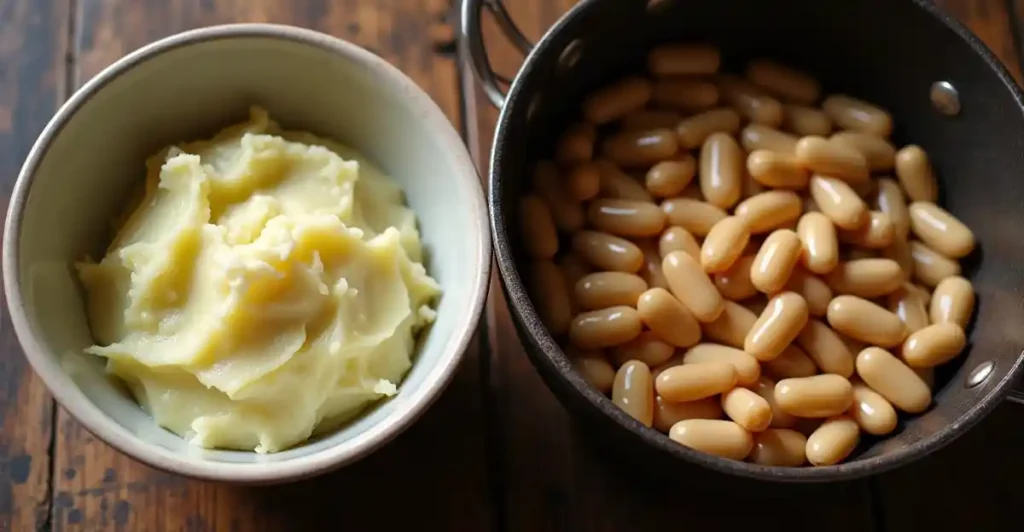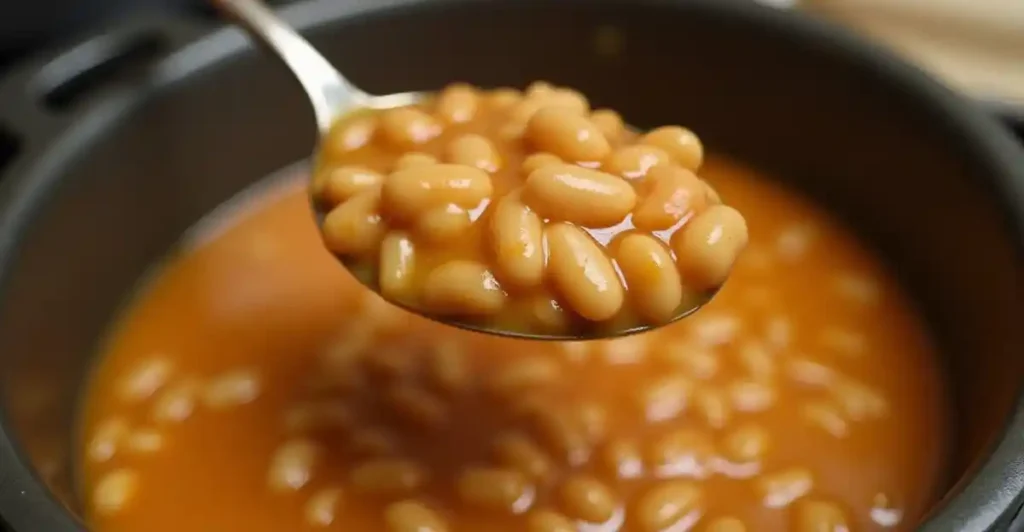How to Thicken Up Calico Beans
Why Consistency Matters in Calico Beans
Calico beans are a beloved comfort food, known for their rich flavors and hearty texture. Whether you’re preparing them for a family dinner or a potluck, achieving the perfect consistency is crucial. A thick, satisfying sauce brings the dish together, ensuring each bite is flavorful and well-balanced.
Common Causes of Thin Calico Beans
Sometimes, despite following a recipe, calico beans turn out thinner than desired. This can happen due to:
- Excess Liquid: Adding too much broth or water during cooking.
- Low Starch Content: Using low-starch beans like kidney beans, which don’t naturally thicken the sauce.
- Improper Simmering: Cooking with the lid on traps steam, preventing the sauce from reducing properly.
Understanding these causes can help you troubleshoot and choose the right thickening method.
Quick and Easy Thickening Methods
Simmering Without a Lid
One of the simplest ways to thicken calico beans is to simmer the dish uncovered. This method allows excess liquid to evaporate, naturally concentrating the flavors and thickening the sauce.
How to Simmer Effectively:
- Remove the Lid: Let the beans cook uncovered on low to medium heat.
- Stir Occasionally: Prevent beans from sticking to the bottom of the pot.
- Monitor Consistency: Check the thickness every 10–15 minutes to avoid over-reducing.
Simmering without a lid not only thickens the beans but also enhances the dish’s flavor by intensifying the spices and seasonings.
Using a Thickening Agent
Thickening agents like flour, cornstarch, or arrowroot powder are quick fixes for calico beans that are too thin. These options are ideal for last-minute adjustments.
Steps to Use a Thickening Agent:
- Prepare a Slurry: Mix 1–2 tablespoons of your chosen agent with an equal amount of cold water to form a smooth paste.
- Add to the Pot: Slowly stir the slurry into the beans while they’re simmering.
- Cook Until Thickened: Allow the beans to simmer for a few more minutes, stirring frequently.
Pro Tip: Cornstarch creates a glossy finish, while flour offers a more matte texture. Choose based on your preference.
Adding Pureed Beans
Another natural way to thicken calico beans is by pureeing a portion of the cooked beans. This method maintains the dish’s flavor and keeps it wholesome.
How to Use Pureed Beans:
- Scoop out ½ to 1 cup of the cooked beans.
- Mash or blend them into a smooth puree.
- Stir the puree back into the pot and mix well.
Pureeing beans adds body to the sauce while preserving the dish’s authentic taste and texture.
Natural Ingredients to Thicken Beans

Mashed Potatoes or Sweet Potatoes
Using mashed potatoes or sweet potatoes is a creative and natural way to thicken calico beans. These starchy ingredients blend seamlessly into the dish, adding richness and depth.
Steps to Use Potatoes:
- Prepare the Mash: Cook and mash 1–2 small potatoes or sweet potatoes.
- Incorporate Gradually: Stir the mash into the beans a little at a time until the desired thickness is achieved.
- Adjust Seasoning: Add salt, pepper, or spices as needed to maintain flavor balance.
Mashed potatoes are particularly effective in bean recipes that call for a creamy consistency.
Tomato Paste or Ketchup
Tomato-based ingredients not only thicken the dish but also enhance its flavor with tangy and slightly sweet notes.
How to Use Tomato Paste or Ketchup:
- Tomato Paste: Stir in 1–2 tablespoons of tomato paste and cook for a few minutes to blend it evenly.
- Ketchup: Add 1 tablespoon for a sweeter flavor profile.
These ingredients are especially useful for calico beans that include tomatoes or other acidic components.
Flour, Cornstarch, or Arrowroot Powder
As mentioned earlier, these versatile thickeners can be used individually or combined with other methods for a foolproof result.
Choosing the Right Thickener:
- Flour: Works well in heartier, rustic recipes but may create a slightly cloudy appearance.
- Cornstarch: Ideal for a glossy, smooth finish.
- Arrowroot Powder: A great gluten-free alternative with a neutral flavor.
Each option can be adjusted based on dietary preferences and the dish’s overall aesthetic.
Techniques for Balancing Flavor and Texture
Adjusting Seasoning After Thickening
Thickening calico beans can sometimes alter the flavor balance of the dish. For instance, starches or potatoes might dilute the spices or seasonings. After thickening, taste the beans and adjust the seasoning to restore their rich flavor.
Steps to Rebalance Flavors:
- Add Spices Gradually: Enhance the dish with cumin, paprika, chili powder, or garlic powder.
- Incorporate Sweetness or Acidity: If the flavor feels flat, add a splash of apple cider vinegar or a teaspoon of brown sugar.
- Test and Taste: Stir well and taste frequently to avoid over-seasoning.
This ensures the beans are as flavorful as they are thick and hearty.
Avoiding Overcooking
While thickening, it’s easy to overcook calico beans, especially when simmering for long periods. Overcooked beans can become mushy, compromising the dish’s texture.
Tips to Prevent Overcooking:
- Use medium heat instead of high to maintain a gentle simmer.
- Stir occasionally to ensure even cooking and prevent sticking.
- If the beans reach the desired thickness but are still cooking, reduce the heat or remove the pot from the stove.
Monitoring cooking time closely helps preserve the beans’ integrity while achieving the perfect consistency.
Adding a Final Garnish for Presentation
Once your calico beans have the desired thickness, a final garnish can elevate their appearance and flavor.
Popular Garnish Options:
- Fresh Herbs: Chopped parsley, cilantro, or green onions add a burst of color and freshness.
- Shredded Cheese: Cheddar, Monterey Jack, or mozzarella enhances the dish’s creaminess.
- Crispy Bacon Bits: Adds a savory crunch, complementing the hearty beans.
These garnishes make the dish visually appealing and even more delicious when served.
Common Mistakes to Avoid

Adding Too Much Liquid
One of the primary reasons calico beans end up too thin is adding excessive liquid during the cooking process. It’s essential to strike the right balance between the liquid and solid ingredients.
Tips to Prevent Overwatering:
- Start with less broth or water than the recipe calls for; you can always add more later.
- Drain canned beans and other liquid-heavy ingredients before adding them to the pot.
- Avoid covering the pot entirely while simmering, as this traps steam and prevents the sauce from reducing.
By controlling the liquid, you’ll create beans with a naturally thick and satisfying consistency.
Using the Wrong Type of Beans
Not all beans are created equal when it comes to thickening calico beans. Some beans, like kidney beans or pinto beans, have more starch, which helps create a creamy texture. Others, like black beans, may not contribute as much to thickening.
Recommended Beans for Calico Beans:
- Pinto Beans: High in starch and perfect for creating a thicker dish.
- Kidney Beans: Add both texture and bold flavor.
- Lima Beans: A creamy option that blends well with other ingredients.
Choosing the right beans ensures a balanced texture that supports the dish’s hearty base.
Overusing Thickeners
While thickeners are helpful, using too much can create an overly dense or pasty texture. The goal is to achieve a natural consistency that complements the dish’s flavors.
How to Avoid Over-Thickening:
- Add thickeners gradually, testing the consistency after each addition.
- Avoid combining multiple thickening methods without adjusting quantities.
- If the dish becomes too thick, thin it out with small amounts of broth or water.
Being mindful of the amount of thickener used ensures a balanced and appetizing final result.
FAQs
Can You Use Instant Thickeners for Calico Beans?
Yes, instant thickeners like cornstarch or instant mashed potatoes are excellent for quick fixes. They work especially well when you’re short on time.
How to Use Instant Thickeners:
- Mix 1–2 tablespoons of the thickener with cold water to create a slurry.
- Stir the slurry into the beans while simmering to prevent lumps.
- Cook for a few minutes to ensure the thickener blends evenly.
Instant thickeners are a convenient option but should be used sparingly to avoid altering the flavor or texture.
What’s the Best Way to Fix Over-Thickened Beans?
If your calico beans have become too thick, there’s no need to panic. It’s easy to adjust the consistency.
How to Thin Over-Thickened Beans:
- Add small amounts of broth, water, or tomato juice to the pot, stirring thoroughly after each addition.
- Incorporate extra diced tomatoes or cooked vegetables for added moisture.
- Heat the beans gently to avoid overcooking while adjusting the texture.
Balancing the thickness ensures the dish remains both flavorful and visually appealing.
Can Slow Cookers Affect the Thickness?
Yes, slow cookers can impact the thickness of calico beans. The sealed lid traps steam, preventing liquid from evaporating, which may result in a thinner consistency.
Tips for Thickening in a Slow Cooker:
- Cook with the lid slightly ajar during the last hour to allow some liquid to evaporate.
- Use less liquid at the beginning, as slow cookers require less water than stovetop methods.
- Add thickeners like cornstarch or pureed beans during the final cooking stages.
Adjusting for the slow cooker’s unique cooking environment ensures a thick and hearty dish.
Are Thickened Calico Beans Suitable for Freezing?
Yes, thickened calico beans can be frozen for later use, but some care is required to maintain their texture.
Freezing Tips:
- Allow the beans to cool completely before transferring them to an airtight container.
- Avoid over-thickening before freezing, as the beans may thicken further upon reheating.
- Thaw in the refrigerator overnight, then reheat gently on the stovetop with a splash of water or broth to restore the desired consistency.
Proper freezing and reheating techniques ensure the beans retain their flavor and texture.
What’s the Ideal Serving Consistency?
The perfect consistency for calico beans is thick enough to coat the back of a spoon but not so dense that it becomes pasty.
How to Achieve the Ideal Consistency:
- Simmer uncovered until the liquid reduces to a creamy sauce.
- Use a balance of starchy beans and additional thickening agents as needed.
- Stir frequently to ensure an even texture and prevent scorching.
This ideal consistency enhances the dish’s appeal and ensures it pairs well with sides like cornbread or rice.
Explore more recipes.